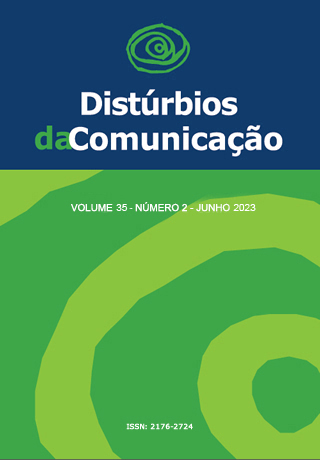Social communication in autistic spectrum disorder
teenagers in a theater context
DOI:
https://doi.org/10.23925/2176-2724.2023v35i2e58624Keywords:
Autism Spectrum Disorder, Language Development, Social Communication, AdolescentAbstract
Introduction: Autism spectrum disorder (ASD) is characterized by persistent impairments in communication and social interaction and by restricted patterns of interests and activities. The condition´s manifestations are present at different levels between individuals and can be evidenced as social demands exceed the limits of their abilities. The hypothesis is that exposure to theatrical activity would generate social communication impacts. Objective: To compare performance in social and language aspects before and after performing a theatrical activity in a group of adolescents with ASD. Method: Twelve individuals with a multidisciplinary diagnosis of ASD with an average age of 16.1 years participated in the study, all with predominantly verbal communication, engaged in educational and/or occupational activities and with at least 75% of frequency in theatrical activities. The aspects of verbal comprehension, inference and memory from the retelling of a story and the answers to a short text in a joke format were evaluated before and after the theatrical activity. These data were related to variables of level of intelligence and adaptive abilities. Results: There was a relationship between performance in language skills and cognitive aspects and adaptive skills and those relationships remained positive before and after the proposed activity. Conclusion: The initial hypothesis was partially confirmed and the results suggest a trend towards improvement in social communication in this context.
Downloads
References
American Psychiatric Association (DSM-V) - Diagnostic and statistical manual of mental disorders (5a ed). Washington, 2013.
ASHA: American Speech-Language-Hearing Association. Scope of practice in speech-language pathology: Scope of practice [Acesso em 12 Nov 2021]. Disponível em: https://www.asha.org/policy/sp2016-00343/
Kaljača S, Dučić B, Cvijetić M. Participation of children and youth with neurodevelopmental disorders in after-school activities. Disabil Rehabil. 2019; 41(17): 2036-2048. doi: 10.1080/09638288.2018.1457092.
Knopf A. Autism prevalence increases from 1 in 60 to 1 in 54: CDC. Brown Univ. Child Adolesc. Psychopharmacol. Update. 2020; 22(6): 6–7. doi: 10.1002/cpu.30499.
Frith U, Happé F. Autism: Beyond “theory-of-mind”. Cognition, 1994, 50(1-3): 115–132. doi: 10.1016/0010-0277(94)90024-8
Perissinoto J. Diagnóstico de Linguagem em Crianças com Transtornos do Espectro Autístico. In: Ferreira L, Befi-Lopes D, Limongi S. (Org.) Tratado de Fonoaudiologia. São Paulo: Roca; 2004. p. 933-40.
Lord C, Elsabbagh M, Baird G, Veenstra-Vanderweele J. Autism spectrum disorder. Lancet. 2018; 392(10146): 508-520. doi: 10.1016/S0140-6736(18)31129-2.
Buxbaum JD, Baron-Cohen S. DSM-V: The debate continues. Mol Autism. 2013; 4-11. https://doi.org/10.1186/2040-2392-4-11
Baker-Ericzén MJ, Fitch MA, Kinnear M, Jenkins MM, Twamley EW, Smith L, Montano G, Feder J, Crooke PJ, Winner MG, Leon J. Development of the Supported Employment, Comprehensive Cognitive Enhancement, and Social Skills program for adults on the autism spectrum: Results of initial study. Autism. 2018 Jan; 22(1): 6-19. doi: 10.1177/1362361317724294.
Menezes CGL e Perissinoto J. Habilidade de atenção compartilhada em sujeitos com transtornos do espectro autístico. Pró-Fono R. Atual. Cient. 2008; 20(4): 273-8. doi: 10.1590/S0104-56872008000400012
Aldred C, Green J, Emsley R, McConachie H. Brief Report: Mediation of Treatment Effect in a Communication Intervention for Pre-School Children with Autism. J Autism Dev Disord. Mar 2012; 42(3): 447-54. doi: 10.1007/s10803-011-1248-3
Shattuck PT, Orsmond GI, Wagner M, Cooper BP. Participation in social activities among adolescents with an autism spectrum disorder. PLoS One. 2011; 6(11): e27176. doi: 10.1371/journal.pone.0027176.
Mcafee, JL. Navigating the social world: a curriculum for individuals with Asperger’s syndrome, high functioning autism and related disorders. Arlington: Future Horizons; 2002. p. 64-108.
Corbett BA, Gunther JR, Comins D, et al. Brief report: theatre as therapy for children with autism spectrum disorder. J Autism Dev Disord. 2011; 41(4): 505-11. doi: 10.1007/s10803-010-1064-1.
Bishop-Fitzpatrick L, Smith DaWalt L, Greenberg JS, Mailick MR. Participation in recreational activities buffers the impact of perceived stress on quality of life in adults with autism spectrum disorder. Autism Res. 2017; 10(5): 973-982. doi: 10.1002/aur.1753.
Oliveira ME, Stoltz T. Teatro na escola: considerações a partir de Vygotsky. Educ. rev. 2010; (36): 77-93. doi:10.1590/S0104-40602010000100007..
Organização Mundial da Saúde. CIF: Classificação Internacional de Funcionalidade, Incapacidade e Saúde. Trad. do Centro Colaborador da Organização Mundial da Saúde para a Família de Classificações Internacionais. São Paulo: EDUSP; 2003.
Perissinoto J, Chiari BM. A Avaliação como precursora de diagnóstico. In: Andrade CRF, Marcondes E, (coordenadores). Fonoaudiologia em Pediatria. São Paulo: Sarvier; 2003. p.135-140.
Golden CJ. Luria Nebraska neuropsychological battery: children’s revision. New York. Administration and Scoring Booklet; 1987.
Lira JO, Tamanaha AC, Perissinoto J, Osborn E. O reconto de histórias em crianças do espectro autístico: um estudo preliminar. Rev.CEFAC. 2009; 11(3): 417-22. doi: 10.1590/S1516-18462009005000021
Osborn E, Pereira LD. Aspectos neuropsicológicos de crianças de 10 anos de idade. Einstein (São Paulo). 2012; 10(4): 433-8. doi: 10.1590/S1679-45082012000400007.
Happé, FGE. An advanced test of theory of mind: Understanding of story characters’ thoughts and feelings by able autistic, mentally handicapped, and normal children and adults. J Autism Dev Disord. 1994; 24, 129–154. doi.org/10.1007/BF02172093
Wechsler D. WISC-III: Escala de Inteligência Wechsler para Crianças: Manual. 3ª ed.São Paulo: Casa do Psicólogo; 2002.
Nascimento E. Adaptação, validação e normatização do teste WAIS-III para um contexto brasileiro. Tese de Doutorado Não-Publicada. Programa de Pós-Graduação do Instituto de Psicologia da Universidade de Brasília, Brasília. No prelo 2004.
Sparrow SS, Balla DA, Cichchetti, VD. Vineland adaptative behavior scales. Interview Edition - Survey form. Circle Pines (MN): American Guidance Service; 1984.
Oficina dos menestréis [https://oficinadosmenestreis.com.br/]. São Paulo: Teatro Oficina dos Menestréis [atualizada em set 2022; acesso em ago 2021].
Westerveld, MF, Filiatrault-Veilleux P, Paynter, J. Inferential narrative comprehension ability of young school-age children on the autism spectrum. Autism & developmental language impairments. 2021; 6: 23969415211035666. doi: 10.1177/23969415211035666.
Kalandadze T, Norbury C, Nærland T, Næss KB. Figurative language comprehension in individuals with autism spectrum disorder: A meta-analytic review. Autism. 2018; 22(2): 99-117. doi: 10.1177/1362361316668652
Aykan S, Nalçacı E. Assessing Theory of Mind by Humor: The Humor Comprehension and Appreciation Test (ToM-HCAT). Front Psychol. 2018; 9: 1470. doi: 10.3389/fpsyg.2018.01470.
Downloads
Published
Issue
Section
License
Copyright (c) 2023 Laís Carvalho Mazzega, Ana Carina Tamanaha, Jacy Perissinoto

This work is licensed under a Creative Commons Attribution 4.0 International License.









